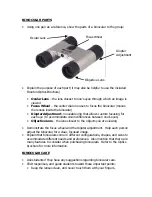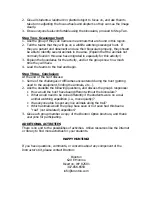
•
If the lenses get smudged, gently rub them with a lens cloth. Do not use
any regular fabric to clean the lenses! Some fabrics can scratch the
lenses, distorting your view.
•
To clean the binocular’s body, use a dry cloth or canned air to remove
surface debris and dirt. Do not spray any solvent directly on the
binocular. To remove more stubborn spots, spray some furniture cleaner
on a rag and apply it to the affected areas.
•
Attach lens caps to the binocular when you’re done viewing. This protects
the lenses and helps prevent dust & debris from accumulating on them.
•
Always store your binoculars in a case when you’re not using them. A
hard case is preferable, since it offers better protection against impact,
but a soft case is better than nothing.
WILDLIFE ACTIVITY
Overview:
This activity will help demonstrate the basics of binocular use. Students will
focus on using optics to help them identify animals more easily when hunting,
bird watching, or simply viewing wildlife. They will learn to apply these skills by
participating in a simulated bird watching/wildlife scavenger hunt.
Time needed:
30-45 minutes
Materials:
•
6 Brunton 5057 model binoculars
•
1 Instructor Activity guide
•
6 Large Wildlife Picture Cards to plant prior to activity
* You may also want to include wildlife pictures of your own! *
Preparation:
1.
Pick a suitable area for your activity. Note: it is best to have an open area for
the binocular instruction/introduction and a wooded area for the scavenger
hunt.
2.
Plant wildlife picture cards in tree branches and thickets along a trail for your
students to spot and identify.
ACTIVITY:
Step One - Binocular practice:
1.
Divide the group into pairs or teams.






















